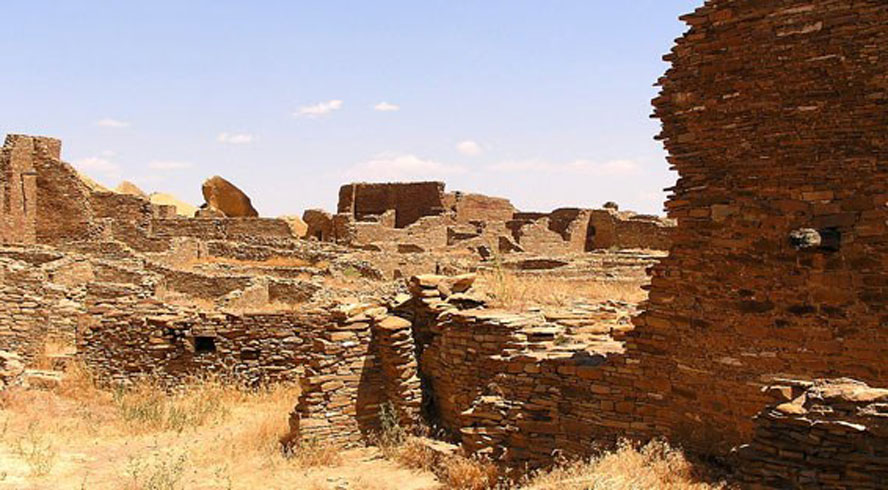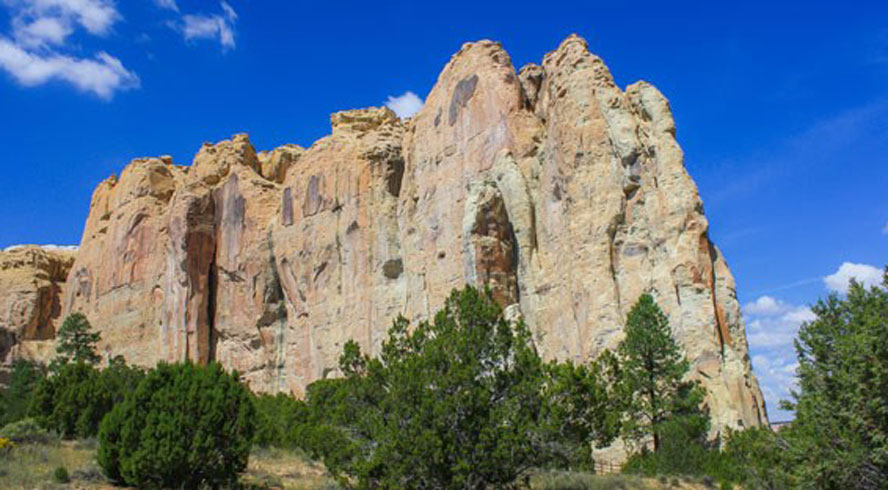Discover 7 Indigenous Landmarks in New Mexico
Have you always wanted to examine petroglyphs as you hike through a pristine sandstone canyon? Are you fascinated by the history of the indigenous peoples who inhabited the Southwest?
If you are intrigued, then a trip to New Mexico’s indigenous landmarks should be in your future. An estimated 11% of New Mexico’s population is comprised of indigenous people, making up 23 Tribes, Nations and Pueblos. For these communities — the Apache, Navajo and Pueblo — many of the state’s most beautiful natural spaces are also sacred ground. Consider these seven places when you plan your next visit to the Land of Enchantment and immerse yourself in the stories that are so important to the state’s indigenous people and their ancestors.

Aztec Ruins National Monument
What is the biggest “secret” of Aztec Ruins National Monument? In short, the monument is not Aztec. When 19th-century settlers first came upon these ruins, they assumed the site was built by the ancient Aztecs, when in truth, the site was built by the Puebloan Indians in the 12th and 13th centuries.
Located along the Trail of the Ancients Scenic Byway in Aztec, New Mexico and along the Animas River, Aztec Ruins National Park was built in 1100 CE and remained inhabited by the Ancestral Pueblo people until around 1300 CE. It was a thriving economic and political center, as well as sacred ground where many ceremonies were performed.
Today, Aztec Ruins National Monument is included on National Register of Historic Places and is included under Chaco Culture as a UNESCO World Heritage Site.

Bandelier National Monument
The Ancestral Pueblo people called the land that is now Bandelier National Monument their home from around 1150 CE to 1550 CE. They built shelters in the volcanic tuft, including multilevel structures and cliff-side dwellings. It is thought that this community eventually moved along the Rio Grande as a severe drought came to the region.
Today, Bandelier National Monument protects this history, as well as more than 30,000 acres of land and habitat — roughly 70% of the park’s acreage. In the 1930s, Bandelier became the country's largest National Park Service Civilian Conservation Corps National Landmark District as more than 70 miles of trails were built so that visitors could explore its history and wildlife.

Chaco Culture National Historical Park
Chaco Canyon National Historical Park was hub of activity for the Chaco people who lived here during the ninth century. It is estimated that at one time, more than 4,000 indigenous people called this site their home, and soon trade routes were opened up with settlements in Arizona, Colorado and northern Mexico.
Today, Chaco Culture National Historical Park is considered to be the sacred ancestral homelands of the Hopi and Pueblo people. The site became part of the national park system in 1907, and was named an UNESCO World Heritage Site 80 years later.

El Morro National Monument
Imagine you are traveling through the desert and come upon an oasis — a reliable water source where a weary explorer could drink up and rest before continuing with their journey.
El Morro National Monument is such an oasis. An estimated 600 Anasazi people resided here from 1275-1350 CE, relying on the water source and its secure location. They carved petroglyphs into the sandstone cliffs, preserving their stories for generations to come. As Spanish explorers and later American settlers discovered the same oasis on their journeys, they also carved their stories into these rocks.
Today, modern travelers would recognize this park as being located in Cibola County, along the Trails of the Ancients Byway. Visitors can choose from three trails to explore, including Inscription Trail, Headland Trail and Atsinna. El Morro National Monument has been designated an International Dark Sky Park for its preservation of historic inscriptions and its natural night sky, and is listed on the National Register of Historic Places.

Gila Cliff Dwellings National Monument
Could you imagine living and raising children in a cliff dwelling? That’s exactly what the Mogollon people did during the late 1200s in what is now the Gila National Forest. (For your modern GPS needs, it’s about 44 miles from Silver City, New Mexico.)
What’s truly notable about the Gila Cliff Dwellings National Monument is that it is the only U.S. monument with Mogollon ruins. The impressive dwellings consist of 40 rooms in various sizes, and the rooms were used for shelter, storage ceremonies and more. Their construction makes it obvious that the Mogollons were not only brave people to live along the side of a cliff – they were also adept engineers with an extremely advanced knowledge of architecture.
After the Mogollon people eventually left this region, the Apache moved in and remained residents until the mid-1800s, making this region significant in the histories of multiple tribes. Visitors to the Gila National Forest can learn about these cultures, as well as take in ample trails, horseback riding opportunities and camping spots available.

Petroglyph National Monument
For nearly 17 miles, Petroglyph National Monument stretches along Albuquerque’s West Mesa. A volcanic plateau that protects five extinct volcanic cones, it’s also the canvas for more than 25,000 petroglyphs created by the Ancestral Puebloans. Though the images in these petroglyphs are often abstract, many can be recognized as humans, crosses, animals and more.
Petroglyph National Monument is actually comprised of four smaller, separate parks that are extremely close to one another. Boca Negra Canyon, Rinconada Canyon, Piedras Marcadas Canyon and Volcano Day Use trails are all part of this unique location, and ample hiking trails are available throughout to explore.
The monument’s location along the edge of Albuquerque is both unique and treacherous. Urban sprawl has forced housing developments to be built right up against the rock formations, and both the National Park Service and the City of Albuquerque preserve the monument.

Three Rivers Petroglyph Site
Animals, sunbursts, handprints and wildlife are just a few of the 21,000 petroglyphs that you might identify during a visit to the Three Rivers Petroglyph Site in New Mexico’s northern Chihuahuan Desert. One of the few locations in the Southwest that is preserved solely for its petroglyph images, Three Rivers Petroglyph Site showcases the images created by the Jordana Mogollon people from 900-1400 CE.
The site is considered by many to be a hidden gem due to the vast amounts of petroglyphs that can be viewed up close, as well as access to a small pueblo ruin nearby.
If you're interested in learning more about Native American history, take a look at our learning adventures in New Mexico.
